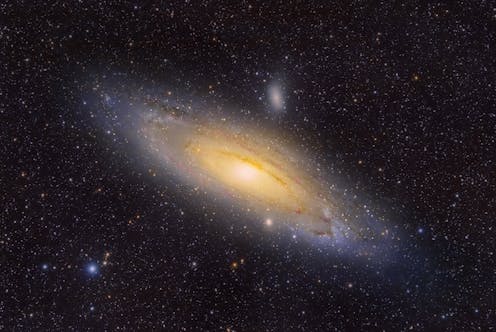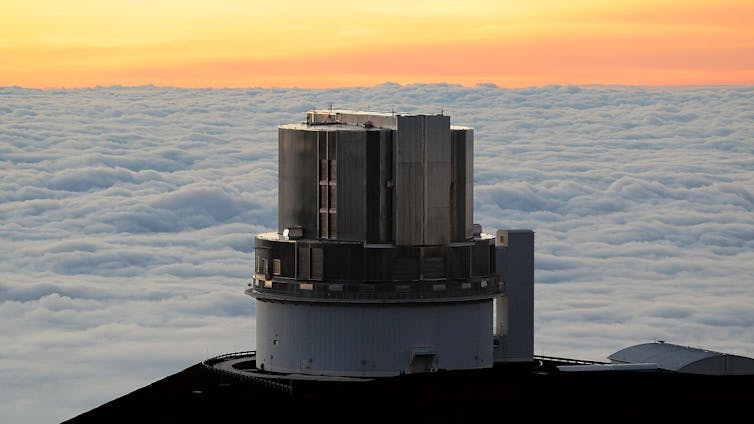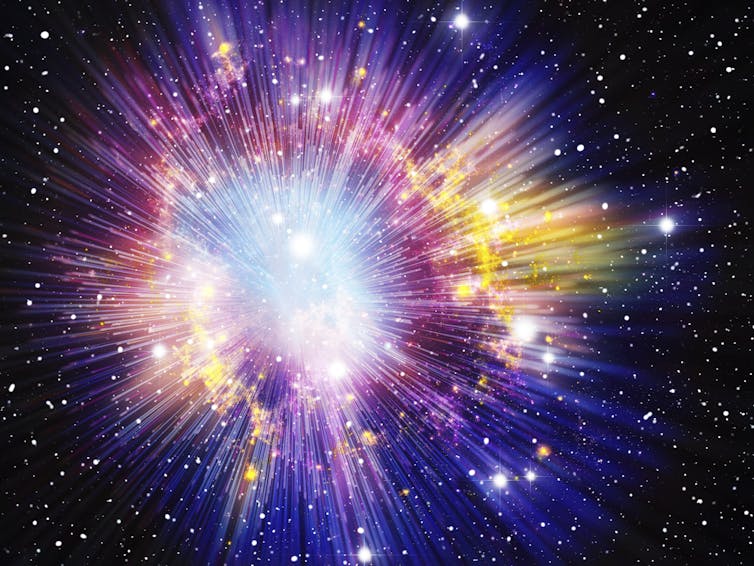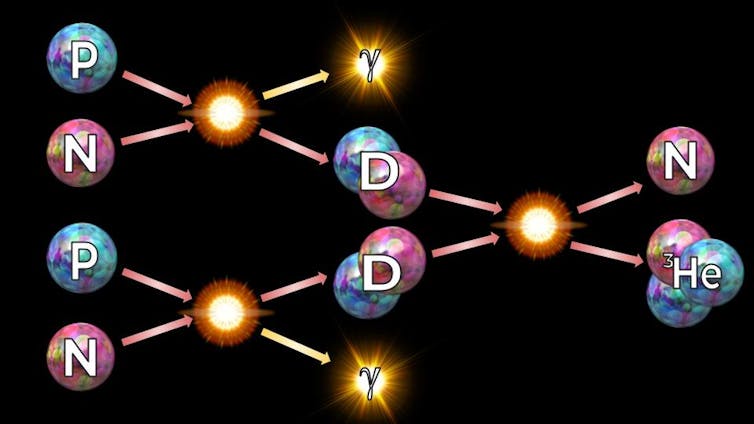Measuring helium in distant galaxies may give physicists insight into why the universe exists
The way particles interacted while the universe was forming seconds after the Big Bang could explain why the universe exists the way it does – a physicist explains matter-antimatter asymmetry.

When theoretical physicists like myself say that we’re studying why the universe exists, we sound like philosophers. But new data collected by researchers using Japan’s Subaru telescope has revealed insights into that very question.

The Big Bang kick-started the universe as we know it 13.8 billion years ago. Many theories in particle physics suggest that for all the matter created at the universe’s conception, an equal amount of antimatter should have been created alongside it. Antimatter, like matter, has mass and takes up space. However, antimatter particles exhibit the opposite properties of their corresponding matter particles.
When pieces of matter and antimatter collide, they annihilate each other in a powerful explosion, leaving behind only energy. The puzzling thing about theories that predict the creation of an equal balance of matter and antimatter is that if they were true, the two would have totally annihilated each other, leaving the universe empty. So there must have been more matter than antimatter at the birth of the universe, because the universe isn’t empty – it’s full of stuff that’s made of matter like galaxies, stars and planets. A little bit of antimatter exists around us, but it is very rare.
As a physicist working on Subaru data, I’m interested in this so-called matter-antimatter asymmetry problem. In our recent study, my collaborators and I found that the telescope’s new measurement of the amount and type of helium in faraway galaxies may offer a solution to this long-standing mystery.
After the Big Bang
In the first milliseconds after the Big Bang, the universe was hot, dense and full of elementary particles like protons, neutrons and electrons swimming around in a plasma. Also present in this pool of particles were neutrinos, which are very tiny, weakly interacting particles, and antineutrinos, their antimatter counterparts.

Physicists believe that just one second after the Big Bang, the nuclei of light elements like hydrogen and helium began to form. This process is known as Big Bang Nucleosynthesis. The nuclei formed were about 75% hydrogen nuclei and 24% helium nuclei, plus small amounts of heavier nuclei.
The physics community’s most widely accepted theory on the formation of these nuclei tells us that neutrinos and antineutrinos played a fundamental role in the creation of, in particular, helium nuclei.
Helium creation in the early universe happened in a two-step process. First, neutrons and protons converted from one to the other in a series of processes involving neutrinos and antineutrinos. As the universe cooled, these processes stopped and the ratio of protons to neutrons was set.
As theoretical physicists, we can create models to test how the ratio of protons to neutrons depends on the relative number of neutrinos and antineutrinos in the early universe. If more neutrinos were present, then our models show more protons and fewer neutrons would exist as a result.
As the universe cooled, hydrogen, helium and other elements formed from these protons and neutrons. Helium is made up of two protons and two neutrons, and hydrogen is just one proton and no neutrons. So the fewer the neutrons available in the early universe, the less helium would be produced.
Because the nuclei formed during Big Bang Nucleosynthesis can still be observed today, scientists can infer how many neutrinos and antineutrinos were present during the early universe. They do this by looking specifically at galaxies that are rich in light elements like hydrogen and helium.

A clue in helium
Last year, the Subaru Collaboration – a group of Japanese scientists working on the Subaru telescope – released data on 10 galaxies far outside of our own that are almost exclusively made up of hydrogen and helium.
Using a technique that allows researchers to distinguish different elements from one another based on the wavelengths of light observed in the telescope, the Subaru scientists determined exactly how much helium exists in each of these 10 galaxies. Importantly, they found less helium than the previously accepted theory predicted.
With this new result, my collaborators and I worked backward to find the number of neutrinos and antineutrinos necessary to produce the helium abundance found in the data. Think back to your ninth grade math class when you were asked to solve for “X” in an equation. What my team did was essentially the more sophisticated version of that, where our “X” was the number of neutrinos or antineutrinos.
The previously accepted theory predicted that there should be the same number of neutrinos and antineutrinos in the early universe. However, when we tweaked this theory to give us a prediction that matched the new data set, we found that the number of neutrinos was greater than the number of antineutrinos.
What does it all mean?
This analysis of new helium-rich galaxy data has a far-reaching consequence – it can be used to explain the asymmetry between matter and antimatter. The Subaru data points us directly to a source for that imbalance: neutrinos. In this study, my collaborators and I proved that this new measurement of helium is consistent with there being more neutrinos then antineutrinos in the early universe. Through known and likely particle physics processes, the asymmetry in the neutrinos could propagate into an asymmetry in all matter.
The result of our study is a common type of result in the theoretical physics world. Basically, we discovered a viable way in which the matter-antimatter asymmetry could have been produced, but that doesn’t mean it definitely was produced in that way. The fact that the data fits with our theory is a hint that the theory we’ve proposed might be the correct one, but this fact alone doesn’t mean that it is.
So, are these tiny little neutrinos the key to answering the age old question, “Why does anything exist?” According to this new research, they just might be.
Anne-Katherine Burns does not work for, consult, own shares in or receive funding from any company or organization that would benefit from this article, and has disclosed no relevant affiliations beyond their academic appointment.
Read These Next
West Antarctica’s history of rapid melting foretells sudden shifts in continent’s ‘catastrophic’ geo
A picture of what West Antarctica looked like when its ice sheet melted in the past can offer insight…
How to reduce gift-giving stress with your kids – a child psychologist’s tips for making magic and a
Depending on family circumstances and a child’s personality type, gift giving runs the gamut of fun…
The world risks forgetting one of humanity’s greatest triumphs as polio nears global eradication − 7
Polio may finally be defeated in the next 5 years. Will the world recognize what an extraordinary achievement…





